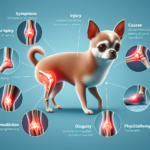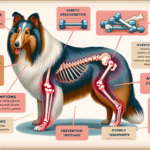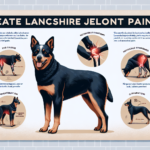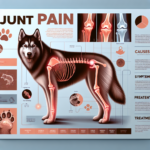Bolognese Joint Pain: Causes, Symptoms, Prevention, and Treatment
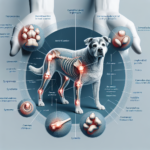
Introduction
The Bolognese, a member of the Bichon family, is a small, white, and fluffy dog breed known for its affectionate and loyal nature. Originating from Italy, the Bolognese has a rich history dating back to the Roman Empire, where they were favored by nobility and aristocrats. This breed is characterized by its compact size, weighing between 5.5 to 9 pounds, and its distinctive white, curly coat. Bolognese dogs are known for their calm demeanor, intelligence, and strong bond with their owners.
Like many small breeds, the Bolognese is prone to certain health issues, including dental problems, eye conditions, and joint pain. Joint health is a significant concern for Bolognese owners, as joint pain can severely impact the quality of life for these dogs. Ensuring good joint health is crucial for maintaining their mobility, comfort, and overall well-being.
Breed-Specific Joint Pain Risks
Genetic Predisposition
The Bolognese breed, like many purebred dogs, has a genetic predisposition to certain joint-related issues. Hip dysplasia, a condition where the hip joint does not fit properly into the hip socket, is one such concern. Although more common in larger breeds, hip dysplasia can still affect smaller breeds like the Bolognese. Additionally, patellar luxation, where the kneecap dislocates from its normal position, is another joint issue that can affect this breed. Arthritis, a degenerative joint disease, can also develop as the dog ages, leading to chronic pain and reduced mobility.
Age-Related Risks
As Bolognese dogs age, the risk of developing joint pain increases. Joint issues such as arthritis and hip dysplasia may become more pronounced with age, leading to discomfort and mobility challenges. Owners should be vigilant about monitoring their Bolognese for signs of joint pain, especially as they reach middle age (around 7-8 years) and beyond. Early detection and intervention can help manage these conditions more effectively.
Activity Level and Joint Stress
The Bolognese is a relatively low-energy breed, but they still require regular exercise to maintain their health. However, excessive or inappropriate exercise can put undue stress on their joints. Activities that involve jumping or sudden changes in direction can be particularly hard on their joints. It’s essential to strike a balance between providing enough exercise to keep them fit and avoiding activities that could exacerbate joint issues.
Common Symptoms of Joint Pain in Bolognese
General Symptoms
Owners should be aware of the general symptoms of joint pain, which can include:
- Limping or favoring one leg
- Stiffness, especially after rest or sleep
- Reluctance to move, jump, or climb stairs
- Decreased activity or playfulness
- Whining or showing signs of discomfort when touched
- Changes in gait or posture
Breed-Specific Symptoms
In Bolognese dogs, joint pain may manifest in specific ways. Due to their small size, even slight changes in their movement or behavior can be more noticeable. Owners might observe their Bolognese having difficulty getting up from a lying position or being less enthusiastic about activities they once enjoyed. Additionally, the breed’s tendency to form strong bonds with their owners means they may become more clingy or seek comfort when in pain.
When to Consult a Vet
If you notice any of the above symptoms in your Bolognese, it’s essential to consult a veterinarian promptly. Early diagnosis and treatment can significantly improve the prognosis for joint issues. Persistent limping, noticeable pain, or any sudden changes in behavior should be addressed by a professional to determine the underlying cause and appropriate treatment plan.
Preventive Measures for Joint Health
Exercise Recommendations
Regular, moderate exercise is crucial for maintaining joint health in Bolognese dogs. Activities such as short walks, gentle play sessions, and swimming can help keep their joints flexible and muscles strong without causing excessive stress. Avoid high-impact activities like jumping or running on hard surfaces, as these can exacerbate joint issues.
Dietary Suggestions
A balanced diet rich in essential nutrients can support joint health. Consider incorporating foods or supplements that contain:
- Glucosamine and Chondroitin: These supplements can help maintain cartilage health and reduce joint pain.
- Omega-3 Fatty Acids: Found in fish oil, these can reduce inflammation and support overall joint health.
- Antioxidants: Vitamins C and E can help protect joint tissues from damage.
Consult your veterinarian for specific dietary recommendations tailored to your Bolognese’s needs.
Weight Management
Maintaining a healthy weight is crucial for reducing joint stress. Excess weight can put additional pressure on the joints, exacerbating pain and discomfort. Monitor your Bolognese’s weight and adjust their diet and exercise routine as needed to keep them at an optimal weight. Regular weigh-ins and body condition assessments can help ensure they stay within a healthy range.
Early Screening and Monitoring
Early screening for joint issues can help catch problems before they become severe. Regular veterinary check-ups should include assessments of joint health, especially as your Bolognese ages. X-rays and other diagnostic tools can help identify conditions like hip dysplasia or arthritis early on, allowing for more effective management and treatment.
Treatment Options for Joint Pain
Non-Surgical Treatments
For many Bolognese dogs, non-surgical treatments can effectively manage joint pain. These may include:
- Medications: Nonsteroidal anti-inflammatory drugs (NSAIDs) can help reduce pain and inflammation. Your vet may also prescribe pain relievers or joint supplements.
- Physical Therapy: Exercises and therapies designed to improve joint function and reduce pain can be beneficial. Hydrotherapy, in particular, is gentle on the joints and can help build muscle strength.
- Lifestyle Adjustments: Modifying your dog’s activity level and providing a comfortable living environment can help manage joint pain. Soft bedding, ramps, and avoiding stairs can reduce stress on their joints.
Surgical Options
In severe cases, surgical intervention may be necessary to alleviate joint pain. Common surgical options for joint issues in Bolognese dogs include:
- Hip Replacement: For severe hip dysplasia, a total hip replacement can provide significant relief and improve mobility.
- Arthroscopy: This minimally invasive procedure can help diagnose and treat joint issues by removing damaged tissue or repairing ligaments.
- Patellar Luxation Surgery: Corrective surgery can stabilize the kneecap and prevent it from dislocating.
Your veterinarian will discuss the best surgical options based on your dog’s specific condition and overall health.
Alternative Therapies
Alternative therapies can complement traditional treatments and provide additional relief for joint pain. These may include:
- Acupuncture: This ancient practice can help reduce pain and inflammation by stimulating specific points on the body.
- Hydrotherapy: Water-based exercises can improve joint function and muscle strength without putting stress on the joints.
- Massage: Regular massage can help relax muscles, improve circulation, and reduce pain.
Consult with a veterinarian experienced in alternative therapies to determine the best options for your Bolognese.
Lifestyle and Management Tips
Daily Care Routine
A consistent daily care routine can help manage and alleviate joint pain in your Bolognese. Consider the following:
- Provide regular, gentle exercise to keep joints flexible.
- Incorporate joint supplements into their diet as recommended by your vet.
- Monitor their weight and adjust their diet and exercise as needed.
- Ensure they have a comfortable place to rest, with soft bedding and easy access to food and water.
Modifying the Home Environment
Making your home more comfortable for a dog with joint pain can significantly improve their quality of life. Consider these modifications:
- Use ramps or steps to help them access furniture or get in and out of the car.
- Provide orthopedic beds that offer better support for their joints.
- Keep their living area free of obstacles to prevent tripping or slipping.
- Place food and water bowls at a comfortable height to reduce strain on their neck and joints.
Long-Term Management
Long-term management of joint pain involves ongoing care and monitoring. Regular veterinary check-ups, consistent exercise, and a balanced diet are essential. Stay vigilant for any changes in your Bolognese’s behavior or mobility, and adjust their care routine as needed. With proper management, your Bolognese can continue to lead a happy and active life despite joint pain.
FAQs About Bolognese and Joint Pain
What are the early signs of joint pain in Bolognese dogs?
Early signs of joint pain in Bolognese dogs include limping, stiffness, reluctance to move, decreased activity, and changes in behavior such as increased clinginess or irritability.
Can joint pain in Bolognese dogs be prevented?
While genetic predispositions cannot be entirely prevented, maintaining a healthy weight, providing regular exercise, and incorporating joint supplements into their diet can help reduce the risk and severity of joint pain.
Are there specific exercises that are better for Bolognese dogs with joint pain?
Yes, low-impact exercises such as short walks, gentle play sessions, and swimming are ideal for Bolognese dogs with joint pain. Avoid high-impact activities that can stress their joints.
What dietary supplements are recommended for Bolognese dogs with joint pain?
Supplements containing glucosamine, chondroitin, and omega-3 fatty acids are commonly recommended to support joint health and reduce inflammation in Bolognese dogs.
When should I consider surgery for my Bolognese’s joint pain?
Surgery should be considered when non-surgical treatments are no longer effective, and your dog is experiencing significant pain or mobility issues. Consult with your veterinarian to determine the best course of action.
Conclusion
Joint pain is a common concern for Bolognese dogs, but with proper care and management, it can be effectively addressed. By understanding the breed-specific risks, recognizing early symptoms, and implementing preventive measures, owners can help ensure their Bolognese maintains good joint health. Regular veterinary check-ups, a balanced diet, appropriate exercise, and a comfortable living environment are key to managing joint pain and keeping your Bolognese happy and active. Always consult with your veterinarian for personalized advice and treatment options to best support your dog’s joint health.

